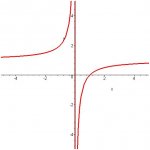Here's the problem:
Show that, if ad ? bc, f(x) = (ax + b)/(cx + d) has no local maxima, no local minima, and no inflection points. Sketch the graph for a = c = 1, b = – 1, d = 0.
I'm able to show that there are no local maxima or minima:
f = (ax + b)/(cx + d)
f' = [(cx + d) ? a – (ax + b) ? c]/(cx + d)[sup:1h0irh2d]2[/sup:1h0irh2d] = (acx + ad – acx – bc)/(cx + d)[sup:1h0irh2d]2[/sup:1h0irh2d] = (ad – bc)/(cx + d)[sup:1h0irh2d]2[/sup:1h0irh2d]
f'' = [(cx + d)[sup:1h0irh2d]2[/sup:1h0irh2d] ? 0 – (ad – bc) ? 2 ? (cx + d) ? c]/(cx + d)[sup:1h0irh2d]4[/sup:1h0irh2d] = 2c(bc – ad)(cx + d)/(cx + d)[sup:1h0irh2d]4[/sup:1h0irh2d] = 2c(bc – ad)/(cx + d)[sup:1h0irh2d]3[/sup:1h0irh2d]
Since ad ? bc, f' is never zero, so there are no local minima or maxima.
Now I'm not sure how to show that there is no inflection point. I can tell from the graph the problem asks for that the function is concave up for x < 0 and concave down for x > 0, but also that it is not continuous at x = 0. So although evidently there is a change of sign in f'' from x < 0 to x > 0, there is no inflection point because x is not defined at 0. My question: How do I show this observation from the graph using math? It seems that f'' could be equal to 0 (and therefore there may be a point of inflection) if c = 0 and d ? 0. I can't think of what the next step should be.
Show that, if ad ? bc, f(x) = (ax + b)/(cx + d) has no local maxima, no local minima, and no inflection points. Sketch the graph for a = c = 1, b = – 1, d = 0.
I'm able to show that there are no local maxima or minima:
f = (ax + b)/(cx + d)
f' = [(cx + d) ? a – (ax + b) ? c]/(cx + d)[sup:1h0irh2d]2[/sup:1h0irh2d] = (acx + ad – acx – bc)/(cx + d)[sup:1h0irh2d]2[/sup:1h0irh2d] = (ad – bc)/(cx + d)[sup:1h0irh2d]2[/sup:1h0irh2d]
f'' = [(cx + d)[sup:1h0irh2d]2[/sup:1h0irh2d] ? 0 – (ad – bc) ? 2 ? (cx + d) ? c]/(cx + d)[sup:1h0irh2d]4[/sup:1h0irh2d] = 2c(bc – ad)(cx + d)/(cx + d)[sup:1h0irh2d]4[/sup:1h0irh2d] = 2c(bc – ad)/(cx + d)[sup:1h0irh2d]3[/sup:1h0irh2d]
Since ad ? bc, f' is never zero, so there are no local minima or maxima.
Now I'm not sure how to show that there is no inflection point. I can tell from the graph the problem asks for that the function is concave up for x < 0 and concave down for x > 0, but also that it is not continuous at x = 0. So although evidently there is a change of sign in f'' from x < 0 to x > 0, there is no inflection point because x is not defined at 0. My question: How do I show this observation from the graph using math? It seems that f'' could be equal to 0 (and therefore there may be a point of inflection) if c = 0 and d ? 0. I can't think of what the next step should be.

